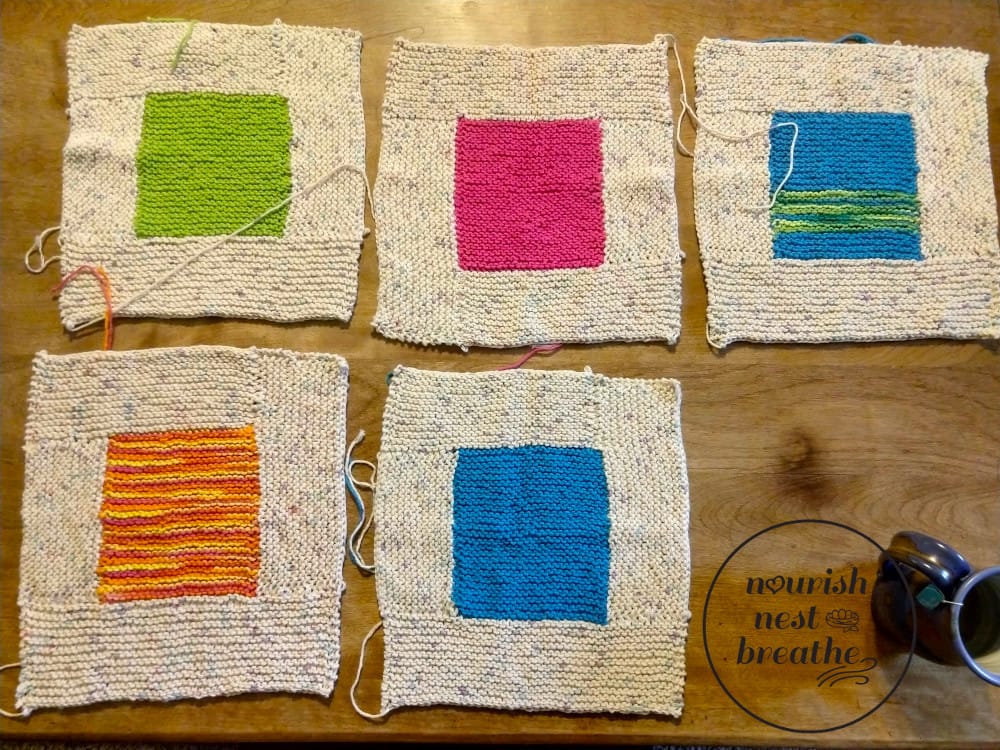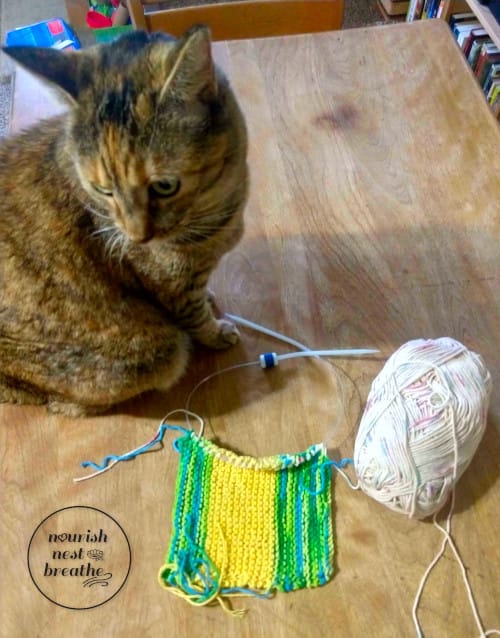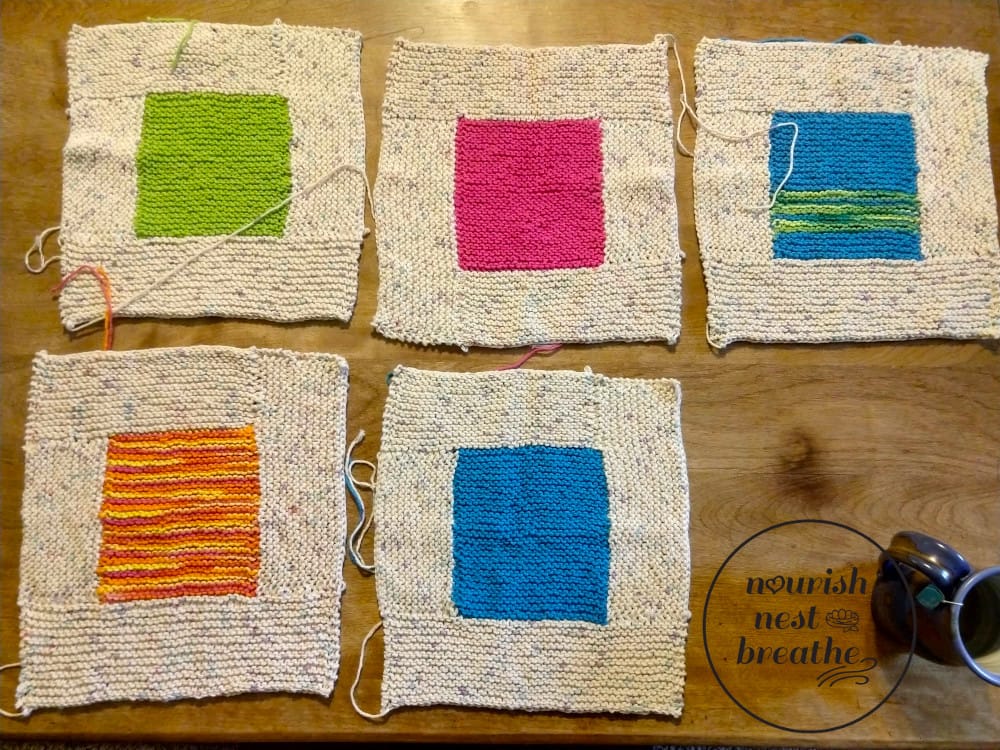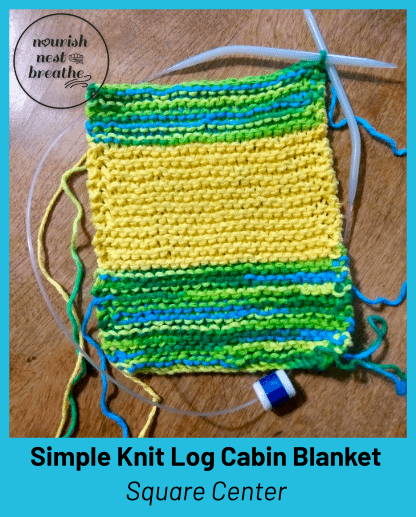
 When I walk into a thrift store the first place I usually check is the yarn and sewing section. And whenever I see a good selection of 100% cotton dishcloth yarn at a good price I pick it up. You can read my ode to dishcloth cotton blankets here to see why I always scoop this yarn up.
When I walk into a thrift store the first place I usually check is the yarn and sewing section. And whenever I see a good selection of 100% cotton dishcloth yarn at a good price I pick it up. You can read my ode to dishcloth cotton blankets here to see why I always scoop this yarn up.
While I was able to find plenty of dishcloth cotton at our thrift stores in Arizona to keep me knitting away (I think you can credit the many people cleaning house once they relocate to Arizona for retirement) I haven’t been so lucky now that we’re in Missouri. As I picked up my knitting bag and realized that I didn’t have nearly enough to get me through a new blanket, I knew I needed to find another source of this yarn.
I try to pick up my yarn at thrift stores for several reasons:
- I really work to reduce my footprint on this planet in reasonable and manageable ways. One of my big tools in this process is buying secondhand and giving items a new lease on life.
- Thrift shopping is like a great treasure hunt and the thrill of finding a bag full of dishcloth cotton yarn in colors I am excited to knit with makes that yarn just a little more special than buying it online or in a big box store.
- I *might* have a little bit of a problem with Joann’s and Michael’s clearance sections. I have a craft room packed with supplies which will probably take me my entire life to use. Part of this is that I’m multi-passionate and have a number of crafts I enjoy, and part of it is I have a little bit of a magpie tendency to be attracted to sparkly shiny things. So to keep myself in check, I venture into these stores as infrequently as possible.
While I didn’t have the time, energy or patience to scour eBay searching for dishcloth cotton yarn, I knew I wanted to find some source that at least addressed a few of the items above.
After doing a good amount of internet searching, I located these 100% cotton dishcloth cotton yarn mill ends from Consumer Crafts. (this appears to no longer be a valid source, and I haven’t found a replacement – please leave a note in the comments if you do!)
While not second-hand, mill ends are something which isn’t saleable through the regular retail supply chain. Buying online also keeps me out of big box stores, and they were a good deal compared to the cost of the same amount of yarn by weight at those big box stores. (Each bag of mill ends is approximately equal to 6 ½ balls of 70 grams each – that puts the mill end bags at almost half the retail price.)
I ordered four bags of yarn (to get free shipping), and hoped that would give me enough combined with what I had in my stash to put together a blanket. I wasn’t sure what I would get (color selection is chosen at random and bags can be all one color or mixed), so I began to imagine many different pattern options as I waited for my box to arrive.
When the yarn finally got here, I had three bags of a cream with variegated spots on it (two had red in the spots, one was missing it) and one bag of just pink yarn. The cream yarn was perfect for one of the ideas I had been mulling over – a simple and modern log cabin quilt with bright pops of color.
I pulled out the yarn I had on hand and selected a palette I thought would work well with the variegated yarn. I knew I wanted to knit blocks and then assemble once complete. So I cast on and started knitting away, formulating as I went along with the first block.
I’ve made the conscious choice to keep ads off my blog because I want you to have the best experience possible! Please consider supporting me in providing this ad free content with a tip:
Here is the “recipe” I am using for this quilt:
Using one of your center colors, cast on 25 stitches (I use the long-tail cast on and count that as my first row), knit 50 rows in garter stitch. As you can see in the pictures, I am mixing solid colors and coordinating bright variegated yarn in these center blocks. My goal is to end up with 25 blocks total and have each one be unique. Once you have completed the 50 rows (25 garter ridges), cast off, keeping the last stitch on the needles.
Now turn your work 90 degrees and on the right side using your background color, pick-up 24 stitches between garter rows (giving you a total of 25 stitches). Knit 24 rows in garter stitch (counting the pick-up row as row 1). This will give you a total of 12 garter ridges in your background color. Cast-off your stitches, again retaining the last stitch on the needle.
No need to cut your yarn, turn the square another 90 degrees, pick-up 11 stitches (total 12) in the background color between garter ridges. Then pick up an additional 25 stitches along the cast on edge of the center color (total of 37 stitches). Knit 24 rows in garter stitch (counting the pick-up row as row 1). This will give you a total of 12 garter ridges in your background color. Cast-off your stitches, again retaining the last stitch on the needle.
Again, no need to cut your yarn, turn the square another 90 degrees, pick-up 11 stitches (total 12) in the background color between garter ridges. Then pick up an additional 25 stitches between garter ridges of the center color (total of 37 stitches). Knit 24 rows in garter stitch (counting the pick-up row as row 1). This will give you a total of 12 garter ridges in your background color. Cast-off your stitches, again retaining the last stitch on the needle.
You should now be on your final side. Again, no need to cut your yarn, turn the square another 90 degrees, pick-up 11 stitches (total 12) in the background color between garter ridges. Then pick up an additional 25 stitches along the cast off edge of the center color. Finally, pick-up 12 stitches between garter ridges on the background color. You should now have a total of 49 stitches. Knit 24 rows in garter stitch (counting the pick-up row as row 1). This will give you a total of 12 garter ridges in your background color. Cast-off all stitches.
Then you just start all over again until you have enough squares to make the blanket of your choice. These squares are approximately 12”x12” and I am hoping to have a blanket that is five squares by five squares (I would love to squeeze in an extra row giving my 5×6 if I have enough of the background color).
As this is a work in progress, I have yet to decide exactly how I will attach the squares. I am thinking I will either sew them up with (hopefully) invisible seaming, or possible use some sort of three needle bind-off/I-cord system to connect the squares. Keep watching for more updates as I continue to work on this project (and to learn how I am going to use the pink yarn – I limit myself to one blanket project at a time)!
Related
One thought on “Simple Knitted Log-Cabin Blanket”
Leave a Reply Cancel reply
This site uses Akismet to reduce spam. Learn how your comment data is processed.






[…] picking up stitches and adding sections through a three needle bind-off. My current project is here if you want to see a blanket in progress as well as get a recipe for how to make one of your […]